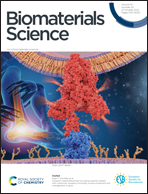A chiral microenvironment promotes retinal progenitor cell proliferation by activating the Akt and ERK pathways†
Abstract
Retinal progenitor cell (RPC) transplantation has been proposed as a potential strategy for the treatment of retinal degeneration, which is a leading cause of vision loss. However, a major obstacle is the poor proliferation of RPCs. Accumulating evidence suggests that the chiral features of the extracellular microenvironment are closely related to cell proliferation. Inspired by this, L/D-phenylalanine-derived molecules (LP and DP) are employed to construct a biomimetic chiral microenvironment for enhancing RPC proliferation. LP and DP self-assemble into left-handed and right-handed helical fibrous networks, respectively. It is found that DP nanofibrous films show an excellent ability in promoting RPC proliferation via the activation of the Akt and extracellular signal-regulated kinase (ERK) pathways. In addition, both LP and DP nanofibrous films have the advantage of attenuating inflammation, and LP films can maintain the stem potential of RPCs. Thus, the promotion of RPC proliferation using a bioinspired chiral fibrous microenvironment is a promising strategy for RPC-based therapies for retinal degeneration.



 Please wait while we load your content...
Please wait while we load your content...